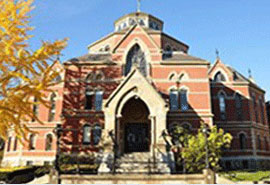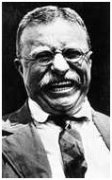
Daniel Carleton Gajdusek
usinfo | 2012-12-05 13:48
Daniel Carleton Gajdusek (pronounced GUY-dah-shek; September 9, 1923 – December 12, 2008) was a Hungarian˙-Slovak-American physician and medical researcher who was the co-recipient (with Baruch S. Blumberg) of the Nobel Prize in Physiology or Medicine in 1976 for work on kuru, the first human prion disease demonstrated to be infectious.

Early years
Gajdusek's father, Karol Gajdusek, was from Smrdáky Kingdom of Hungary now in Slovakia and was an ethnic Slovak who was a butcher. His maternal grandparents, ethnic Hungarians of the Calvinist faith, emigrated from Debrecen, Hungary. Gajdusek was born in Yonkers, New York, and graduated in 1943 from the University of Rochester, where he studied physics, biology, chemistry and mathematics. He obtained an M.D. from Harvard University in 1946 and performed postdoctoral research at Columbia University, the California Institute of Technology, and Harvard. In the early 1950s, Gajdusek was drafted into the military as a research virologist at Walter Reed Army Medical Center. In 1954 he went to work as a visiting investigator at the Walter and Eliza Hall Institute of Medical Research in Melbourne, Australia. There, he began the work that culminated in the Nobel prize.
Kuru
Gajdusek's best-known work focused on kuru. This disease was rampant among the South Fore people of New Guinea in the 1950s and 1960s. Gajdusek connected the spread of the disease to the practice of funerary cannibalism by the South Fore. With elimination of cannibalism, kuru disappeared among the South Fore within a generation.
Gajdusek was introduced to the problem of kuru by Vincent Zigas, a district medical officer in the Fore Tribe region of New Guinea. Gajdusek provided the first medical description of this unique neurological disorder, which was miscast in the popular press as the "laughing sickness" because some patients evinced risus sardonicus as a symptom. He lived among the Fore, studied their language and culture, and performed autopsies on kuru victims.
Gajdusek concluded that kuru was transmitted by the ritualistic consumption of the brains of deceased relatives, which was practiced by the Fore. He then proved this hypothesis by successfully transmitting the disease to primates and demonstrating that it had an unusually long incubation period of several years. This was the first demonstration of the infectious spread of a non-inflammatory degenerative disease in humans.
Kuru was shown to have remarkable similarity with scrapie, a disease of sheep and goats caused by an unconventional infectious agent. Subsequently, additional human agents belonging to the same group were discovered. They include sporadic, familial, and variant Creutzfeldt–Jakob disease. Though Gajdusek was not able to identify the exact biological nature of the infective agent that spreads kuru, further research of scrapie agent by Stanley Prusiner and others led to the identification of rogue proteins called prions as the cause of these diseases.
While Gajdusek's work is generally accepted by the medical community, some have questioned whether cannibalism was still practiced at the time of Gajdusek's research. Willam Arens, an anthropologist known for his criticism of reports of learned cannibalism, claims that Gajdusek never actually witnessed cannibalism himself. Researchers who worked with the Fore in the 1950s claimed that cannibalism was suppressed in 1948, almost a decade before Gajdusek arrived in New Guinea. Arens further alleges that the stories presented as evidence of Fore cannibalism often contradict each other and contain elements of sexism and racism. According to Arens, the decline of kuru coincided with the arrival of Europeans to the area in 1961, an event that caused many substantial changes in Fore life that could have led to the improvement in health conditions. Nevertheless, the problem is not cannibalism but the women using the grandfathers brain to rub on their children's babies skin. The last explanation given by Gajdusek before his death was that the women retained scraps of the brain under their nails, and that when they scratched the child's head looking for vermin, they then inoculated the disease. Rubbing the skin was not sufficient, according to him, for a transmission of kuru. The decline of kuru is linked to the establishment of schools and medical stations, due to the pressure exerted by Gajdusek upon the local Australian authorities, and the fact that the disease had become internationally sexy, and that new villages were built with more modern amenities i.e. running water close to the houses.
In contrast, many other researchers, including Robert Klitzman, S. Lindenbaum, R. Glasse, and kuru field researchers at the Papua New Guinea Institute of Medical Research have documented reports that confirm the practice. Gajdusek became head of the laboratories for virological and neurological research at the National Institutes of Health (NIH) in 1958 and was inducted to the National Academy of Sciences in 1974 in the discipline of microbial biology.
Child molestation conviction
In the course of his research trips in the South Pacific, Gajdusek had brought 56 mostly male children back to live with him in the United States, and provided them with the opportunity to receive high school and college education. He was later accused by one of these, now an adult man, of molesting him as a child.
Gajdusek was charged with child molestation in April 1996, based on incriminating entries in his personal diary and statements from a victim. He pleaded guilty in 1997 and, under a plea bargain, was sentenced to 12 months in jail. After his release in 1998, he was permitted to serve his five-year unsupervised probation in Europe. He never returned to the United States and lived in Amsterdam, Paris, and Tromsø. Gajdusek's treatment had been denounced from October 1996 as anti-elitist and unduly harsh by controversial Edinburgh University psychologist Chris Brand.
The documentary The Genius and the Boys by Bosse Lindquist, first shown on BBC Four on June 1, 2009, notes that "seven men testified in confidentiality about Gajdusek having had sex with them when they were boys", that four said "the sex was untroubling" while for three of them "the sex was a shaming, abusive and a violation". One of these boys, the son of a friend and now an adult, appears in the film. Furthermore, Gajdusek openly admits to molesting boys and his approval of incest. The film tries to understand not only Gajdusek's sexual mores, but also his deeper motivations for science, exploration and life.
Death
Gajdusek died December 12, 2008 in Tromsø, Norway, at the age of 85. He was working and visiting colleagues in Tromsø at the time of his death.
Share this page



















